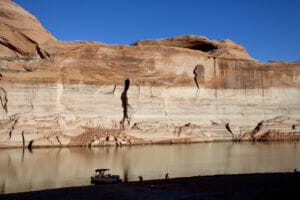Forget “The Valley of the Sun.” Imagine “The Venice of the Southwest.”
It’s an idea that’s hard to fathom now, especially when most Valley residents think of canals as “ugly, smelly and dangerous,” says Nan Ellin, a former Arizona State University professor who conceived Canalscape with her students.
Canalscape is a concept that encourages Phoenicians to embrace the canals that give life to the desert by developing “places of urban vitality” where major streets meet canals, Ellin says.
Despite the canals’ bad reputation, Valley Forward Association and Ellin see a bright, watery future for Phoenix. With more than 181 miles of canals, Phoenix has more of such waterways than Venice and Amsterdam combined. But unlike their European counterparts, canals in Phoenix are not a vital part of the city’s culture.
“The canals used to be the front porch and they became the back alleys,” with the urban sprawl of the 1960s and 1970s, Ellin says.
Valley Forward is committed to transforming the canals from eyesores to amenities, says Jay Hicks, chair-elect of Valley Forward.
“Canalscape represents the next evolution of Valley Forward being able to really bring their membership to a project,” Hicks says.
He adds that the diversity of Valley Forward’s members will help establish connections and relationships between cities, developers, the Salt River Project and other entities to push Canalscape forward.
Currently, the Canalscape project is in the research and discussion stages in Valley Forward’s land use and open space committee. By the end of this year, Valley Forward hopes to create a separate Canalscape committee to allow all of Valley Forward’s members to participate in the creation process, says George Pasquel III, chair of the land use and open space committee.
Canalscape fits perfectly with two of Valley Forward’s goals — promoting sustainability and giving Phoenicians a high quality of life, Hicks says.
Two important aspects of the Canalscape vision are to bring nature into the city by not hardscaping the selected areas, and to keep the ground level spaces public to attract visitors.
“When the ground floor is public, it’s saying welcome,” Ellin notes.
Each “canalscaped” location would have a unique look. The Canalscape developments could range from a naturally landscaped public recreation area to a public school to small urban hubs complete with restaurants, grocery stores and dry cleaners, Ellin says.
Canalscape’s urban centers would create a lifestyle in which walking, biking and mass transit replace cars as the main modes of transportation, thus making the Valley more sustainable and increasing the quality of life, Ellin says.
Currently, there are several locations being considered for Canalscape’s pilot project, but no decisions have been made.
“The best location for a pilot project is whatever location can get implemented the fastest, have the most positive public impact and be the greatest catalyst for future locations,” Pasquel says.
Gateway Community College, which houses the Canalscape Exhibit, is a possible location and GCC President Eugene Giovannini says he hopes the college is chosen.
“I can’t think of another area in the city that is more worthy of the initial pilot project (to) move (Canalscape) forward, because of its location as it relates to mass transit and an underserved, underdeveloped area in the city,” Giovannini says.
The METRO Light Rail’s 38th Street stop at Gateway Community College will connect to Sky Harbor International Airport’s tram when it is completed. As a result, the stop becomes the front door to the city for visitors, and the city should roll out an attractive welcome mat, Giovannini says.
Whichever location is chosen, Pasquel says he hopes to see Canalscape fully developed in the coming decade.
“I’d like (the canal system) to be an active part of the Valley that’s not so ignored, that people … actually think of it as a thoroughfare that connects areas,” he says.
Canalscape connects the Valley, while also maintaining each community’s uniqueness by involving a “combination of urban and nature, and a combination of live, work, play that you don’t see anywhere else in the Valley,” Ellin says.
“So it would really improve the quality of life … and overall it would really enhance the reputation of the Phoenix metropolitan region.”








